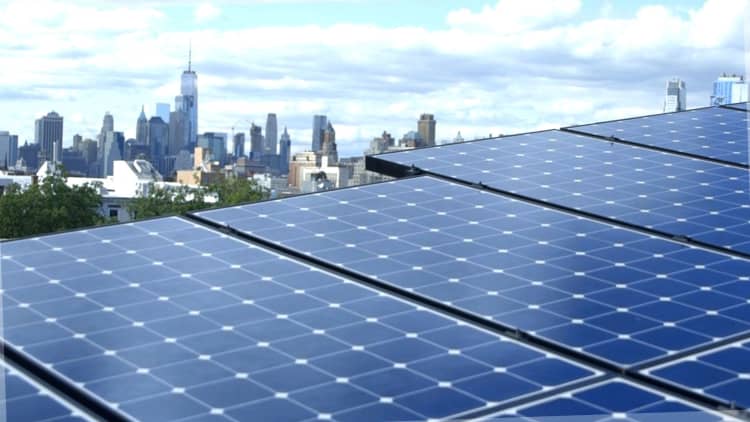California will be the first state in the U.S. to require solar panels on all new homes starting 2020, but the legislation's passage did not end the debate over a key question: Does the cost of installing solar pay off for homeowners?
Some developers are not even waiting for 2020 and are pressing ahead with solar-powered homes for what they say is the best reason: it is simply what best serves the homebuyer market matching energy demands to efficiency and cost. The state estimates the new solar power rule will help homeowners save about $19,000 in a 30-year period. Others say the mandate will push up housing costs too much for many homebuyers.
There's another way to look at the question: Does adding solar power increase a home's value at time of sale? According to real estate information company Zillow, in some states the answer already is yes. Zillow's research indicates that in the same way homeowners are willing to pay thousands of dollars for renovations like a new kitchen or finished basement, they need to evaluate the return on investment from investing in solar energy.
Installing solar panels in a home not only helps to reduce current monthly utility bills; it can potentially increase the home's value by up to 4.1% more than comparable homes with no solar panels, according to recent solar research done by Zillow — or an additional $9,274 for the median-valued home in the U.S.
Green houses
Recent natural disasters like the California wildfires, heat waves throughout Europe and extreme melt events have inspired many to seek more eco-friendly lives, including home buyers.
"There is increased demand for green living. More than 80% of buyers now say energy-efficient features are important in selecting their home," said Sarah Mikhitarian, Zillow senior economist. "We are increasingly finding that these attributes are important to prospective homebuyers. This is part of the reason that there is a premium associated with it. The other piece is that there is true value provided by solar panels — namely, future energy savings."
The energy savings depends in part on how a specific home consumes energy. For example, a home that features heated floors might see a greater premium from the addition of solar (though this was not a correlation Zillow specifically researched).
"For homeowners who know they consume a lot of power, those future savings are worth spending a bit more money up front," Mikhitarian said.
To identify the solar premium in each state, Zillow compared the sale prices of homes with and without solar-energy systems listed for sale and sold within the research period — March 2018 and February 2019. The company examined all transactions that occurred and identified which homes featured solar panels in their listing descriptions, controlling for observable attributes including size, age, location, and market value at the time it was listed for-sale. Zillow also controlled for local market dynamics and the time of the year that the home sold.
In New Jersey, homes with solar panels can sell for 9.9% more than homes without solar-energy systems. That is a profit of $32,281 for the median-valued home in that state.
Here's the top 10 states with the highest solar premiums, according to Zillow's findings:
- New Jersey: 9.9% or $32,281 for the median-valued home.
- Pennsylvania: 4.9% or $8,589 for the median-valued home.
- North Carolina: 4.8% or $8,996 for the median-valued home.
- Louisiana: 4.9% or $7,037 for the median-valued home.
- Washington: 4.1% or $15,916 for the median-valued home.
- Florida: 4% $9,454 for the median-valued home.
- Hawaii: 4% or $24,526 for the median-valued home.
- Maryland: 3.8% or $10,976 for the median-valued home.
- New York: 3.6% or $10,981 for the median-valued home.
- South Carolina: 3.5% or $5,866 for the median-valued home.
However, solar premiums can vary within state lines.
While the solar premium for the state of Florida is 4%, it increases to 4.6% in Orlando, Florida.
In New York City the solar premium is 1.8% more than it is statewide, which translates to $23,989 more in value for the typical home in New York.
And in California there are major fluctuations within metro areas: while the solar premium statewide is 3%, in San Francisco, it increases to 4.4%, in Los Angeles to 3.6% , but in Riverside, the solar premium declines to 2.7%.
Other states like Utah, did not have enough homes with solar-energy systems installed to identify the solar premium.
"There's been a widening of reasons why people are going solar," said Evelyn Huang, chief customer experience officer at Sunrun, the biggest solar installation company in the U.S. — it competes directly with Tesla, which acquired its main competitor SolarCity. "One of the reasons is savings, I think that's the obvious one. The second one is control," Huang said, referring to monthly expenses.
"Our utility companies are needing more and more money to maintain, and they pass on that cost to the homeowner. But that is pretty unpredictable for a homeowner. You just don't know how much your prices are going to increase," Huang said. "I think that is another reason why customers are considering solar. They want to know how much they are going to pay every month. If you're on a fixed income, you need a budget. You need to know what to expect."
Homeowners who made the solar switch
Lisa and Jerry Chretien, a couple from Cape May County, New Jersey, decided to lease solar rooftop panels from Sunrun a year ago. High utility bills and the desire to live cleaner and greener lives inspired them to make the decision. Since going solar in June 2018, the Chretien's electric bills have decreased, especially in the summertime.
"As soon as we would open the pool and turn on the air conditioners in May … our electric bills would run close to $800, sometimes more," said Lisa Chretien. "Saving money, especially with kids in college, has been a big help and a big saving. And there are a lot of incentives, tax wise you get a break. It has just been a plus all the way around."
For Kerrie Lane, owner and operator of a cleaning service and resident of South Jersey, the experience was similar. After moving into her new home, she received her first electric bill: a staggering $1,100. Kerrie knew she needed to do something to make her electric bills affordable.
"I'm 60 years old, so I'm getting up there. I do a physical job for a living but I can't do it forever. ... So having my bills being manageable was very important to me," Lane said. "My first electric bill in this house was $1,100. I knew I needed to correct this situation and make it manageable and Sunrun gave me the consistency that I was looking for. "

A Sunrun spokesman said that assuming annual utility rate increases —the current national average utility rate increase per year is around 3% — solar customers see an average utility bill savings of anywhere from 10% to 40%. Solar contracts include a fixed price of energy per kilowatt/hour that is typically lower than utility rates in most regions across the U.S.
The Sunrun spokesman noted that customers still must pay basic utility infrastructure charges separate from the power generation cost, for wire maintenance, for example, and may also still use some power generation from the utility's sources, depending on the size of their home and level of energy use, as well as the season. Seasonality is an issue for utilities too. In the summer, for example, prices tend to be higher to meet the demand, according to the U.S. Energy Information Administration.
Depending on their deal with Sunrun — which offers service plans, loans, prepayments and cash purchases — customers may also pay monthly charges to the company. Sunrun says that more than 85% of customers do not buy the system outright but pre-pay a set amount and then make monthly service plan payments.
We saw that there was an opportunity here to try and give the best of both worlds to our home buyers.Brandon De Youngexecutive v.p. of net-zero energy homebuilder De Young Properties
Residential home construction company De Young Properties in California built its first net-zero energy building in 2013 — that means it has the potential to produce as much clean energy as it would consumer on a yearly basis.
De Young began redesigning its traditional home prototype in 2008 in order to find a way to build comfortable, energy-efficient homes, at an affordable price. "We wanted to build better homes. We didn't want to stagnate and just build the same home that my grandfather used to build because we felt that it was important to continue to progress," said Brandon De Young, executive v.p. of the company, which has three decades of history.
"Basically, you either have to sacrifice your comfort for your energy bill or your energy bill for your comfort. And we saw that there was an opportunity here to try and give the best of both worlds to our home buyers," said De Young.
Caveats
Many homeowners lease solar panels from companies including Sunrun and Tesla, meaning at time of a home sale the seller needs to buy out the lease or the seller needs to find a buyer who is willing to take over that lease. Solar leasing companies do provide services for transferring the lease. If the previous owner was entitled to state or federal tax credits related to the solar project, that financial incentive would not transfer to the new owner.
Like any home improvement, solar energy systems have a limited useful life. After 20 years or more, solar panels do generally start producing less energy and that would take away some of the value associated with the solar panels, which would likely be reflected in its premium for a specific home. But Zillow noted that this is similar to many other attributes of a home. For example, HVAC systems often need to be replaced after about 10 to 15 years, but people still highly value having air conditioning and are willing to pay a premium for it.
Investment tax credits offered by the federal government to invest in renewable energy projects including solar are scheduled to be phased out for residential homeowners in 2022, but the lobbying fight over this tax credit — currently as high as 30% — is ongoing. If phased out, it would take away one incentive for a homebuyer to purchase a solar system, though costs are coming down at the same time. Bill Gates recently remarked that solar and wind no longer need the support that other sources of renewable energy do and government incentives should be phased out, and he added that solar and wind companies should now be large enough to drive down costs through economies of scale.





